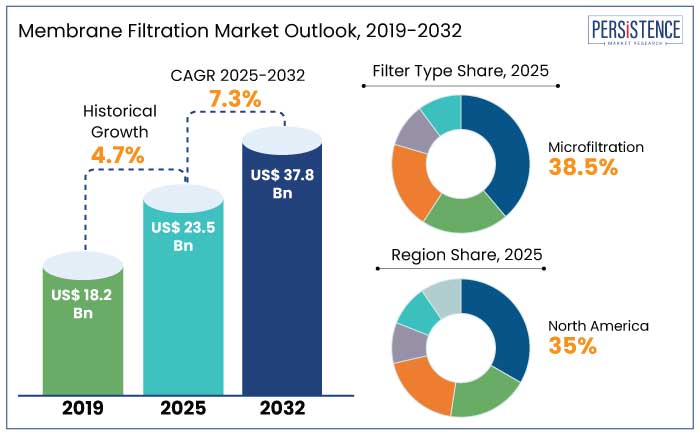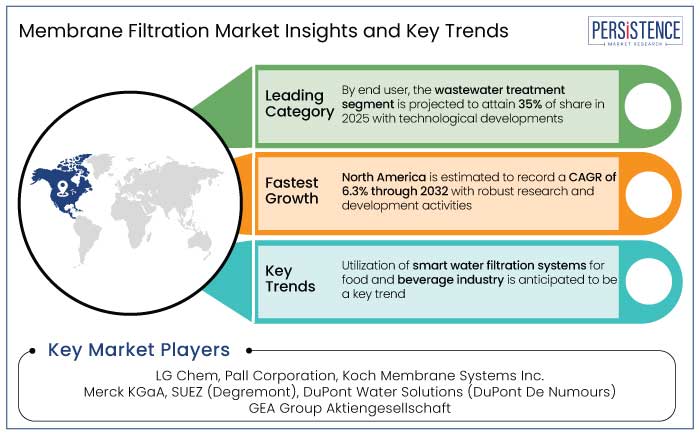Industry: Healthcare
Published Date: January-2025
Format: PPT*, PDF, EXCEL
Delivery Timelines: Contact Sales
Number of Pages: 195
Report ID: PMRREP33138
The global membrane filtration market is estimated to increase from US$ 23.5 Bn in 2025 to US$ 37.8 Bn by 2032. The market is projected to record a CAGR of 7.3% during the forecast period from 2025 to 2032.
Rising consumer awareness of safety issues and technological improvements that improve applications in the food and beverage sector are projected to fuel growth in the membrane filtering market. In the dairy industry, membrane systems are widely used for milk concentration and whey protein recovery. For instance, in October 2023, SUEZ Water Technologies launched its INDU-COR™ HD system, which improves operational efficiency in wastewater treatment and reduces costs.
The bio-based pharmaceutical industry is using membrane filtering to produce sterile drugs and generics, but its uptake may be hampered by the high cost of installation and maintenance. Innovations such as Dow’s RO membranes, introduced in November 2023, promise greater efficiency and longevity, driving adoption across multiple sectors despite these challenges in the industry.

Key Highlights of the Market
|
Market Attributes |
Key Insights |
|
Membrane Filtration Market Size (2025E) |
US$ 23.5 Bn |
|
Projected Market Value (2032F) |
US$ 37.8 Bn |
|
Global Market Growth Rate (CAGR 2025 to 2032) |
7.3% |
|
Historical Market Growth Rate (CAGR 2019 to 2023) |
4.7% |
In 2025, North America is estimated to attain a market share of 35%. By leveraging novel technology, the region is estimated to record a CAGR of 6.3% through 2032.
North America is anticipated to dominate the worldwide membrane filtering market because of the expanding food processing industry, the significance of clean water, and the healthcare sector. Membrane filtration is utilized in water treatment facilities and residential plumbing, whereas microfiltration enhances the efficacy of RO and other treatment systems. These elements affect the design and production of membrane filters in North America.
Europe dominates the global membrane filtration market and is set to account for 45% of share in 2025. This is due to stringent regulations and developments in dairy, brewery, and pharmaceutical applications.
Suez Water Technologies, Veolia Water Technologies, and GE Water & Process Technologies are enhancing water quality and sustainability by investing in innovative filtration solutions. As observed by Veolia Water Technologies' 2022 acquisition of OWS Group in Europe’s membrane filtration sector, regional competitors are stepping up acquisitions and partnerships to satisfy growing demand.
The membrane filtration industry in Europe is projected to showcase a CAGR of 7.5% from 2025 to 2032. This is due to its applications in industrial water treatment, wastewater management, and food and beverage processing.
Microfiltration is predicted to dominate the membrane filtration industry, holding 38.5% of share in 2025. This technology is widely used in industries like water treatment, food and beverage, pharmaceuticals, and biotechnology, as it efficiently removes suspended particles and debris while consuming minimal energy.
Global adoption of microfiltration is on the rise due to increasing demand for clean water and wastewater treatment. For example,
The global membrane filtration market is witnessing rapid growth in the wastewater treatment segment, with a projected 35% share in 2025. It is mainly driven by environmental sustainability and efficient water management solutions.
Companies such as Veolia Water Technologies and Suez Water Technologies are leading the way in developing novel membrane solutions for wastewater treatment, addressing regulatory requirements, and increasing demand for sustainable water practices. Dow Water & Process Solutions has introduced low-pressure RO membranes for wastewater recovery, while regional initiatives like the European Union's (EU) Water Framework Directive are driving investments in membrane-based wastewater treatment systems.
The membrane filtration market is experiencing significant growth driven by rising demand for clean water, stricter environmental regulations, and developments in filtration technologies. Key sectors such as water treatment, food and beverage processing, pharmaceuticals, and biotechnology are increasingly adopting membrane filtration solutions to enhance product quality and efficiency.
Among the various filtration technologies, microfiltration, ultrafiltration, nanofiltration, and reverse osmosis are gaining popularity due to their ability to deliver high-quality filtration while consuming less energy. Innovations aimed at improving energy efficiency and reducing operational costs are fueling market growth, along with increasing applications in wastewater treatment and desalination projects.

The global market for membrane filtration systems recorded a decent CAGR of 4.7% from 2019 to 2023. Membrane filtration is a technique that uses a variety of materials, such as thin-film composite membranes, to separate molecules with different sizes and characteristics.
Reverse osmosis, ultrafiltration, nanofiltration, microfiltration, and chromatographic filters are the five types of membrane filters that are often used. Both the cost and the cost of installation are reduced for these filters. The increase in waterborne illnesses, which are leading sources of morbidity and death, is predicted to increase the need for membrane filtration in the future. For example,
Growth of the membrane filtration industry will likely be driven by the creation of innovative technologies to meet this need. The global market is predicted to exhibit high growth at a value CAGR of 7.3% and attain a size of US$ 37.8 Bn by 2032.
Rising Need for Membrane Filtration in Desalination Plants to Spur Demand
Government programs and growing investments in desalination facilities are predicted to propel the global water treatment market's expansion. Water pollution brought on by urbanization, industry, and population expansion is mostly to blame for the increase in demand for water filtration.
Membrane filtering system investments are rising due to governments pressuring chemical industries to provide better water treatment technologies. For instance,
As water shortage intensifies, desalination facilities are becoming more prevalent, and investments in these plants will generate significant possibilities for producers of membrane filtering systems.
Food and Beverage Industry to Augment Sales
The food and beverage sector is using membrane filtering technologies more and more to eliminate dangerous germs and guarantee safe, high-quality, and valuable goods. Filtration technologies offer great efficiency, energy savings, and environmental protection by combining the processes of separation, concentration, purification, and refining. They are utilized in the production of dairy and soy products, fruit and vegetable juices, food additives, brewing, sugar, enzyme preparations, and egg whites.
While filtration technology may filter, separate, concentrate, and clarify liquid solutions while adhering to laws, the rising trend of organic farming and sustainability has sparked worries about food safety. Filtration has various advantages in the manufacture of wine and beer, including cost-effectiveness and quicker turnaround times.
Requirement of Large Amount of Raw Material May Hamper Supply
Membrane filtration requires a large number of raw materials to manufacture. The availability The availability and pricing of the various raw materials needed for membrane filtering are determined by supply and demand patterns. For water filtration, less expensive substitutes like zirconia and alumina are being investigated.
After two to three years of operation, polymeric microfiltration membranes undergo increased trans-membrane pressure because of irreversible fouling in industries. This raises the cost, maintenance costs, and power consumption.
Overuse and financial considerations make it difficult for the sector to adopt stringent environmental regulations and sustainability requirements. The majority of countries impose severe rules, with wealthy countries enforcing stricter regulations than economically weak countries.
Launch of Novel Water Treatment Solutions to Create Growth Avenues
Growing need for safe and clean drinking water is a key factor driving the significant expansion of the worldwide membrane filtration market. Novel water treatment systems are receiving more attention due to areas experiencing water shortages and growing populations.
Leading-edge technologies like reverse osmosis (RO) and ultrafiltration offer effective desalination and wastewater treatment techniques.
The adoption of sophisticated filtering technology is further fueled by strict environmental laws in industries like municipal and industrial water management.
Innovations in Sustainable and Energy-efficient Solutions to Bolster Prospects
The emphasis on sustainability and energy efficiency is driving innovation in the membrane filtration market. As industries aim to reduce their environmental impact, there is a demand for membranes that minimize energy consumption while ensuring high filtration performance.
Companies like Dow Water & Process Solutions are investing in the development of low-energy-consuming membranes, such as its RO membranes designed to optimize energy use in wastewater treatment.
Automation and smart technologies are becoming integral, with IoT and AI-enabled systems optimizing filtration processes in real-time. This integration of smart technologies not only enhances efficiency but also provides a competitive edge to industry players, ensuring compliance with sustainability goals.
The market for producing membrane filtration filters is fragmented since there are several competitors. Businesses are extending their client base and meeting consumer demand by launching new products, forming alliances, and executing mergers and acquisitions.
Global large firms produce the majority of membrane filtration technology, however, new minor players in Asia Pacific are growing due to more knowledge. These tactics consolidate this fragmented market.
Recent Industry Developments
|
Attributes |
Details |
|
Forecast Period |
2025 to 2032 |
|
Historical Data Available for |
2019 to 2023 |
|
Market Analysis |
US$ Billion for Value |
|
Key Country Covered |
|
|
Key Market Segments Covered |
|
|
Key Companies Profiled |
|
|
Report Coverage |
|
|
Customization and Pricing |
Available upon request |
By Filter Type
By End User
By Region
To know more about delivery timeline for this report Contact Sales

The market is estimated to surge from US$ 23.5 Bn in 2025 to US$ 37.8 Bn by 2032.
Membrane Bioreactors (MBR) are used in food, dairy, and pharmaceutical facilities to treat waste by creating a barrier layer that allows water to pass.
LG Chem, Pall Corporation, Koch Membrane Systems Inc., Merck KGaA, SUEZ (Degremont), and DuPont Water Solutions are few of the leading industry players.
The market is projected to record a CAGR of 7.3% during the forecast period from 2025 to 2031.
Membrane filters, shaped like pleated cartridges, are utilized in various industries, including food and beverage, electronics, pharmaceuticals, and process water/industrial water.